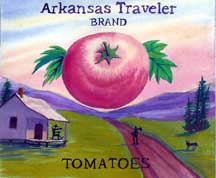 |
Earth Journal
by Gary Pendleton
|
An Heirloom Tomato Is a Treasure
List of heirlooms: 125-year-old clock, mahogany tilt-top table (made by my cabinet-maker grandfather), 60-year-old oil painting, antique tools, tomato plants … Say what?
Generations ago, before the age of supermarket grocery stores, it was common for families to grow their own produce. For many folks, home gardens were the only sources of fresh and canned vegetables.
My grandfather, the cabinet-maker, was born in 1894 into a family of sober, self-reliant people. They made their own food, furniture, houses and even music. After a go at growing oranges in Florida — the groves were abandoned after a series of cold winters — the Pendleton’s took up farming in Harford County, Maryland. In the days when water came from the well and food was locally grown and eaten, gardeners saved seeds.
food was locally grown and eaten, gardeners saved seeds.
Over the seasons, gardeners selected seeds from plants that performed best under local conditions. This practice created a great variety of tomatoes, beans, corn and so on, many of which are still used today, known as heirlooms.
The genetic variety stored in the myriad of seed types is one of our nation’s great natural resources. It’s so valuable that the Federal Government maintains a National Seed Storage Laboratory in Fort Collins, Co. Should a major food source, potatoes for example, be threatened by a new disease mutation, the cure will, we hope, be found in the genetic resources within the seeds the lab is keeping.
Heirloom tomatoes come in a great variety of shapes. Colors vary from red to pink to yellow to white. Some are striped, and some are so dark as to be called blacks. The names are a riot: Dixie Golden Giant, Green Zebra, Dingwall Scotty. Have you ever tasted the Mortgage Lifter?
From the Ozark Mountain’s came a medium-sized, pink variety with excellent flavor and disease resistance. Named after a 19th century fiddle tune, the Arkansas Traveler has shown me it’s a very good variety for Maryland because it performs well in hot, humid conditions and resists cracking. True to its name, it travels well. I’ve packed ripe fruits for camping trips; even after a few days bouncing around, they did not turn to mush. You’ll have a hard time finding them at the garden center, but the seeds can be purchased from a catalog.
The tune “Arkansas Traveler” is one you have probably heard. It holds a place in American musical history next to famous tunes such as “Soldiers Joy” and “Turkey in the Straw.” It comes from the days when music was home grown, too. Fiddle tunes came over from Europe or sprouted up from local soil. They were saved and passed around, like heirloom seeds, and they fed the need for music before the days of radio and records.
The folks in Arkansas are justifiably proud of their namesake nightshade, so they made their state fruit and blossom a vine-ripe pink tomato.




 food was locally grown and eaten, gardeners saved seeds.
food was locally grown and eaten, gardeners saved seeds.